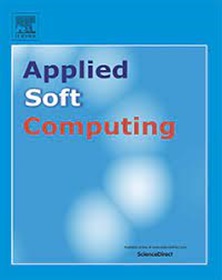Overlapping community detection based on graph attention autoencoder and self-trained clustering
IF 7.2
1区 计算机科学
Q1 COMPUTER SCIENCE, ARTIFICIAL INTELLIGENCE
引用次数: 0
Abstract
Existing methods for detecting overlapping communities often rely solely on the attributes of the nodes and the network structure, but fail to make full use of the similarity relationship between nodes and their neighbors. Additionally, these methods lack effective utilization of a priori information, making it challenging to extract information about community structure and nonlinear data information in overlapping communities. To address these issues, a method for detecting overlapping communities based on a graph attention autoencoder and self-training clustering (GASTC) is proposed. Firstly, GASTC utilizes the graph attention autoencoder for overlapping community detection. The fuzzy modularity maximization method is embedded into the graph attention autoencoder to perform soft allocation of network nodes. Simultaneously, targeted learning is conducted based on the weights assigned to nodes and their neighboring nodes to capture the interactions between overlapping nodes and different communities. GASTC also designed a structural similarity function suitable for detecting overlapping communities. The community structure within overlapping communities is extracted through a semi-supervised learning approach that not only utilizes label information to enhance the prior, but also introduces connection probabilities between nodes. This enables the calculation of the structural similarity between the known network structure and unlabeled nodes. Finally, subspace clustering is used for self-training, where the cluster labels is used to supervise the learning of potential node features and self-expression coefficient matrices. The obtained self-expression coefficient matrix is used to guide the division of clusters, to capture the non-linear data information in overlapping communities. Experimental results on six datasets demonstrate that GASTC can achieve higher accuracy in overlapping community detection tasks, especially in networks with more complex structures.
基于图注意自编码器和自训练聚类的重叠社区检测
现有的重叠社团检测方法往往仅仅依赖于节点的属性和网络结构,而未能充分利用节点与相邻节点之间的相似关系。此外,这些方法缺乏对先验信息的有效利用,难以提取群落结构信息和重叠群落的非线性数据信息。为了解决这些问题,提出了一种基于图注意自编码器和自训练聚类(GASTC)的重叠社区检测方法。首先,GASTC利用图关注自编码器进行重叠社区检测。将模糊模块化最大化方法嵌入到图注意自编码器中,实现网络节点的软分配。同时,根据节点及其相邻节点的权重进行有针对性的学习,捕捉重叠节点与不同社区之间的相互作用。GASTC还设计了一个适合于检测重叠群落的结构相似性函数。通过半监督学习方法提取重叠社区内的社区结构,该方法不仅利用标签信息增强先验,而且引入了节点之间的连接概率。这使得计算已知网络结构和未标记节点之间的结构相似性成为可能。最后,利用子空间聚类进行自训练,利用聚类标签监督潜在节点特征和自表达系数矩阵的学习。利用得到的自表达系数矩阵指导聚类划分,捕捉重叠群体中的非线性数据信息。在6个数据集上的实验结果表明,GASTC在重叠社区检测任务中具有较高的准确率,特别是在结构较为复杂的网络中。
本文章由计算机程序翻译,如有差异,请以英文原文为准。
求助全文
约1分钟内获得全文
求助全文
来源期刊

Applied Soft Computing
工程技术-计算机:跨学科应用
CiteScore
15.80
自引率
6.90%
发文量
874
审稿时长
10.9 months
期刊介绍:
Applied Soft Computing is an international journal promoting an integrated view of soft computing to solve real life problems.The focus is to publish the highest quality research in application and convergence of the areas of Fuzzy Logic, Neural Networks, Evolutionary Computing, Rough Sets and other similar techniques to address real world complexities.
Applied Soft Computing is a rolling publication: articles are published as soon as the editor-in-chief has accepted them. Therefore, the web site will continuously be updated with new articles and the publication time will be short.
 求助内容:
求助内容: 应助结果提醒方式:
应助结果提醒方式:


